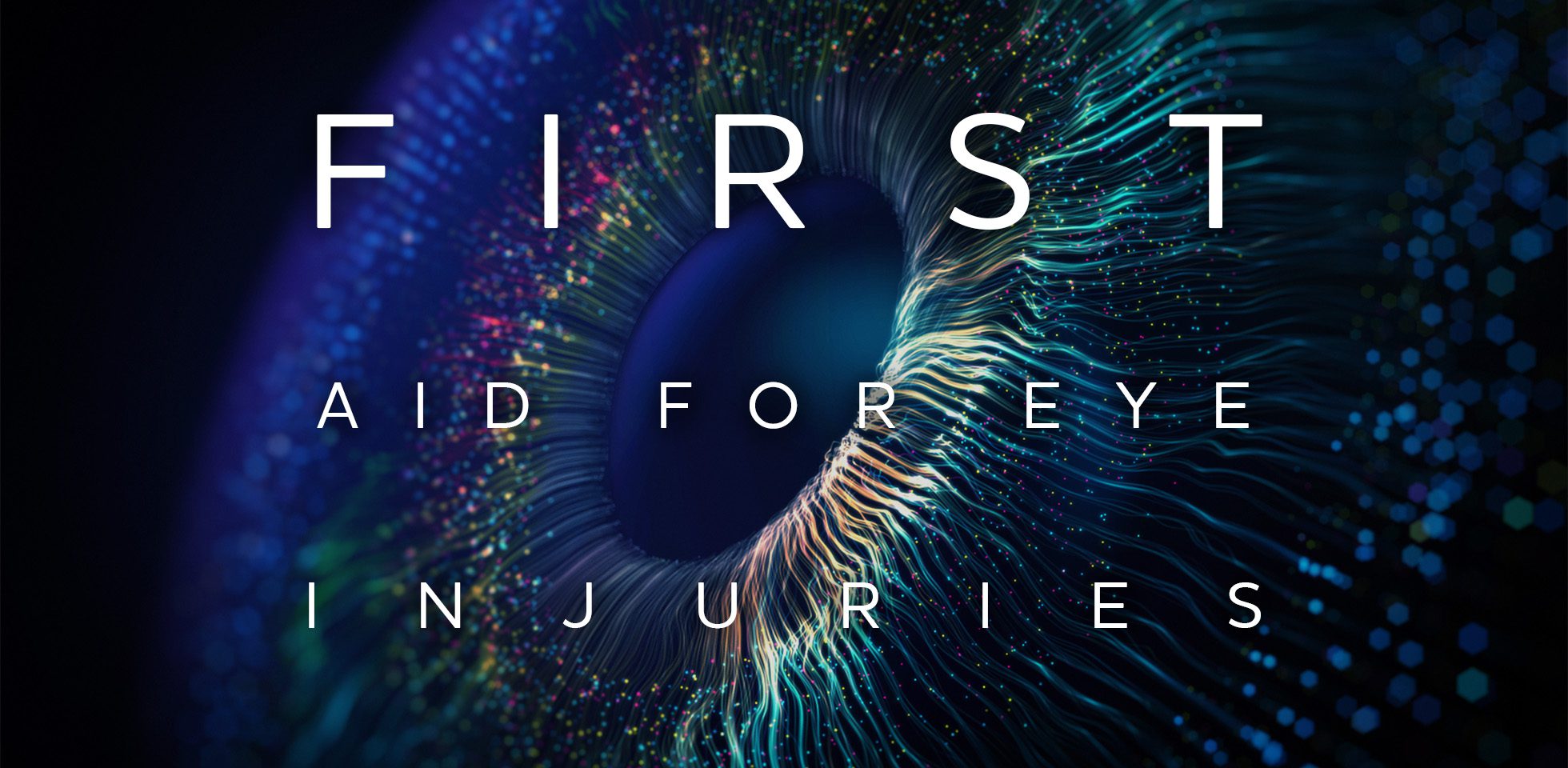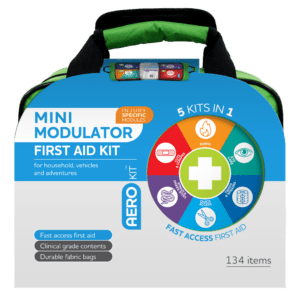First Aid for Eye Injuries & Emergencies
As remarkable and complex as our eyes are, they are also one of the most sensitive parts of the human body, vulnerable to a variety of injuries that can result in partially impaired vision and even blindness. In Australia, almost 13,000 people were presented to the emergency department for an eye injury each year, with 500 hospitalisations arising from work-related eye injuries. In addition, sports-related ocular traumas contributed to 1,793 cases between 2015-2020. When eye irritation or injury does occur, administering rapid first aid can greatly reduce the risk of infection, vision impairment and/or loss of sight. In this blog, we cover what to do and what not to do in the event of eye emergencies, as well as how you can prevent accidents at home, outside and in the workplace.
What NOT to do with an Eye Injury
Whether you’re dealing with a major or minor eye injury, there are some actions that should be avoided all the same.
- DO NOT allow the patient to rub their eye
- DO NOT touch the eye
- DO NOT allow the patient to remove their contact lens if the eye is severely injured
- DO NOT attempt to remove any object which is penetrating or embedded in the eye
- DO NOT apply direct pressure to the eye when bandaging
- DO NOT flush the eye with anything other than clean water or saline (unless the injury has been caused by a chemical burn, in which case you may require a neutralising eyewash such as diphotherine).
General Rules for Managing an Eye Injury
Most eye injuries will first require the patient and responder to administer DRSABCD. This is a first aid action plan that stands for: Danger, Response, Send for help, Airway, Breathing, CPR and Defibrillation.
Also, when treating eye injuries, it is recommended that the responder wash their hands thoroughly and put on disposable nitrile gloves, such as the AeroGlove, to prevent infection. In an emergency, stay calm and call 000.
Managing Major and Minor Eye Injuries
Smoke in the Eye
Smoke from burning material is a common source of eye irritation, often causing the eye to become red, watery and bloodshot.
How to Treat:
- Administer DRSABCD
- Advise the patient not to rub their eye
- Flush the eye with clean water or saline
- Seek medical aid if appropriate
Thermal Burns to the Eye
Exposure to flames, steam and other forms of radiant heat can cause thermal burns to the surface of the eye leading to pain, swelling, redness and watering.
How to Treat:
- Administer DRSABCD – call Triple Zero (000) if needed
- Gently retract the upper eyelid and cautiously flush the eye with cool flowing water for 20 minutes
- Carefully place an eye pad or soft non-adherent dressing over the injured eye
Chemical Burns to the Eye
Common chemicals such as glues, fuels, acids and cleansers can also cause serious chemical burns which require immediate first aid. Chemical burns may require use of a diphoterine solution instead of water or saline, as this can quickly neutralise a wide range of both acid and alkali chemicals, to prevent further reaction.
How to Treat:
- Administer DRSABCD – call Triple Zero (000) if needed
- Gently retract the upper eyelid and cautiously flush the eye with diphoterine
- Carefully place an eye pad or soft non-adherent dressing over the injured eye
Ultraviolet Burns
Exposure to ultraviolet light from the sun, snow (reflecting the sun) or from welding equipment (Welder’s flash) is a common cause of eye irritation and injury, often resulting in tearing, swelling, blurry vision and light sensitivity. Depending on the severity of the burn, the damage and symptoms may resolve within a few days. However, it is still important to administer first aid and see a doctor to prevent possible infection.
How to Treat:
- Place an eye pad, such as the AeroPad or sterile, non-adherent dressing to the injured eye (a cool, moist dressing may also be preferable)
- Seek medical care
Wounds to the Eye
Powerful impacts to the eye from objects such as balls, fists and hard surfaces in the course of recreation and work can cause:
- Laceration and bruising to the eyelid and the surrounding tissue
- Fracturing of the bones within the eye socket
- Broken blood vessels within the eye
- Rupturing of the eye
Because lacerations to the eyelid tend to cause profuse bleeding, it is important to apply a dressing such as the AeroPad as soon as possible.
How to Treat:
- Administer DRSABCD
- Position a clean, light dressing, such as the AeroPad, over the injured eye?making sure to not apply pressure to the eyeball?and carefully tape the dressing in place
- Position the patient comfortably on their back
- Advise the patient to not move their eye
- Seek medical aid if appropriate
Penetrating Eye Injury
This is a very severe type of eye injury in which a sharp object has pierced the outer layer of the eye, either dislodging or continuing to protrude from the eyeball. Common causes of penetrating eye injuries include glass shards, nails, scissors, sticks and knives. Infection and severe loss of vision are common to penetrating injuries, as such the patient should be admitted to an emergency department for professional medical attention as soon as possible.
How to Treat:
Do not attempt to remove the object if it continues to penetrate the eye as this may cause further damage.
- Call Triple Zero (000)
- Administer DRSABCD
- Position the patient comfortably on their back
- Position thick pads such as the AeroPad above and below the injured eye
- Tape the pads with strong adhesive tape such as the AeroTape, to secure them in place, making sure to not apply pressure to the eye
- Advise the patient to not move their eye
- Refrain from allowing the patient to eat or drink
Small Foreign Objects in the Eye
When a small foreign object becomes lodged on the surface of the eye (cornea) or trapped beneath the upper or lower lid, the eye will naturally try to flush the foreign body away with tears. However, if this does not remove the object, it may be necessary to administer first aid. Makeup, dirt, wood/metal slivers, glass and insects are some common examples of foreign objects that can scratch the cornea, leading to infection and possible scarring.
How to Treat:
-
- Administer DRSABCD
- Tell the patient to look up and gently proceed to pull the lower eyelid down and out
- If the foreign object is visible, use an eye spear, such as the AeroProbe, or eye wipe, such as the Double-Ended Eye Wipe to dislodge it
- If the foreign object is not visible, tell the patient to look down and gently proceed to pinch the eyelashes of the upper eyelid
-
- Pull the upper eyelid out and over the lower lid, asking the patient to blink
- If the foreign object is now visible, use an eye spear or eye wipe to dislodge it
- If the foreign object still remains in the eye, gently flush the eye with clean water or saline, such as AeroWash Eyewash Ampoules
- If the foreign object still remains in the eye, treat it as an embedded object
Embedded Objects in the Eye
A foreign object is considered to be embedded in the eye when it fails to be dislodged after a flush of clean water or saline has been administered.
How to Treat:
- Administer DRSABCD
- Position a clean, light dressing, such as the AeroPad, over the injured eye?making sure to not apply pressure to the eyeball?and carefully wrap or tape the dressing in place
- Seek medical care
How to Prevent an Eye Injury
General safety protocols that can reduce the risk of an eye injury include:
- Wearing eye protection in any setting where there is flying debris (e.g. sand, dust, sawdust)
- Wearing eye protection in sports that involve high speed projectiles (e.g. cricket, squash, clay shooting, paintball)
- Keeping a distance from those who are:
- operating machinery at a workbench
- chopping wood
- mowing lawns
- Keeping a distance from low-hanging branches
- Wearing eye protection when metalworking or woodworking (e.g. welding, woodturning, soldering)
- Carrying sharp objects vertically with the pointed end facing down
- Facing nozzles away from your face (e.g. spray bottles, hoses)
- Covering saucepans and frying pans to prevent splatter
- Always retaining adequate supervision over children who are handling risky items (e.g. scissors, pencils, rubber bands, staples)
Promoting Eye Safety at Work
In Australia, eye injuries have shown to be most prevalent across the construction, manufacturing, agriculture, forestry, fishing and mining industries. To reduce the chance of eye injuries occurring in high-risk workplaces, it is recommended that:
- Employers provide and maintain task-appropriate eye protection and first aid eye equipment on site
- Workers be required to wear eye protection when necessary
- Signposts be applied to workplace areas and equipment that require eye protection
- Worker undergo safety training sessions and be provided with written eye safety programs
- Ensure your Workplace contains an eyewash station such as the Drop Eyewash or at least contains eyewash ampoules in the first aid kit.
Promote Eye Health with Aero Healthcare
When eye injuries occur, it is critical that first aid be applied as quickly as possible to reduce the risk of infection and further damage to the patient’s vision. As such, having the proper equipment on hand to treat a range of eye injuries is essential.
At Aero Healthcare, we stock a wide range of high-quality first aid products designed specifically to treat all types of eye injuries.
Our AEROWASH Drop Eye Wash Station, saline solutions and DROP eyewash station refill bottles are perfect for safely flushing foreign objects from the eye or irrigating eye burns.
Our AEROPROBE Eye Spears and Double-Ended Eye Wipes offer exceptional precision and safety when dislodging small foreign objects from the eye.
The wall-mountable REGULAR Eyewash First Aid Kit, complete with saline, conforming bandage, paper tape and Non-Adherent Eye Pads, allows you to treat a variety of minor eye injuries, rapidly.
References:
https://www.betterhealth.vic.gov.au/health/healthyliving/eye-safety-at-work
https://pubmed.ncbi.nlm.nih.gov/28330646/
https://www.betterhealth.vic.gov.au/health/conditionsandtreatments/eye-injuries-chemical-burns



 Introducing the NEW Mini Modulator - perfectly sized for taking on your next adventure!
Introducing the NEW Mini Modulator - perfectly sized for taking on your next adventure!
